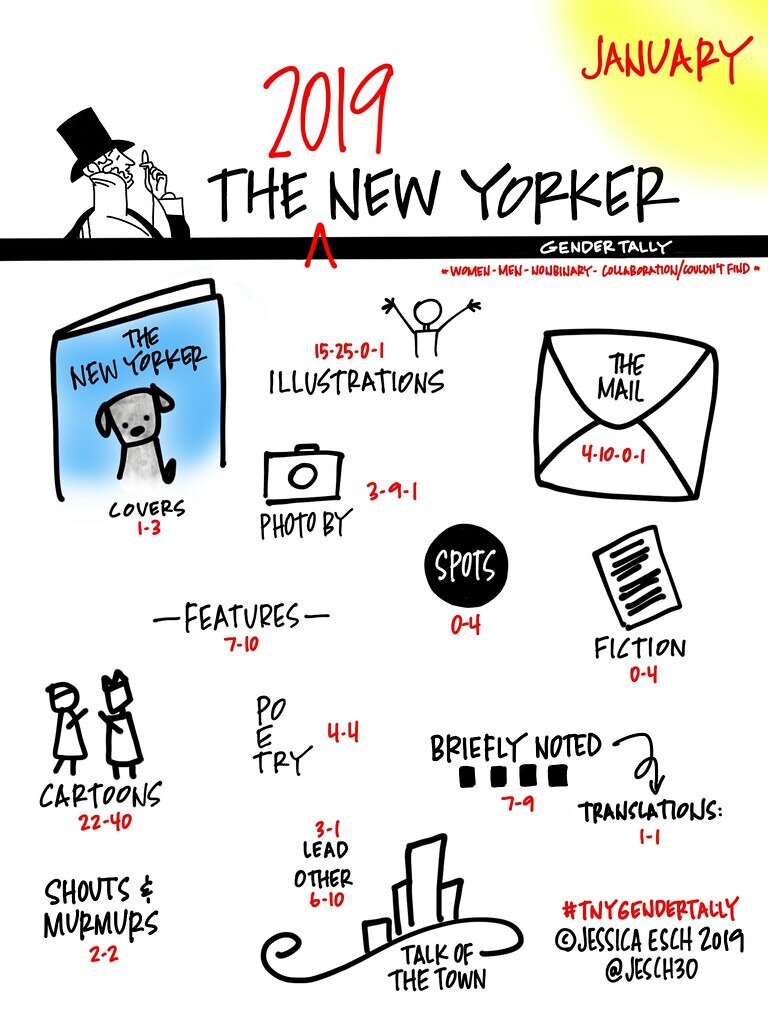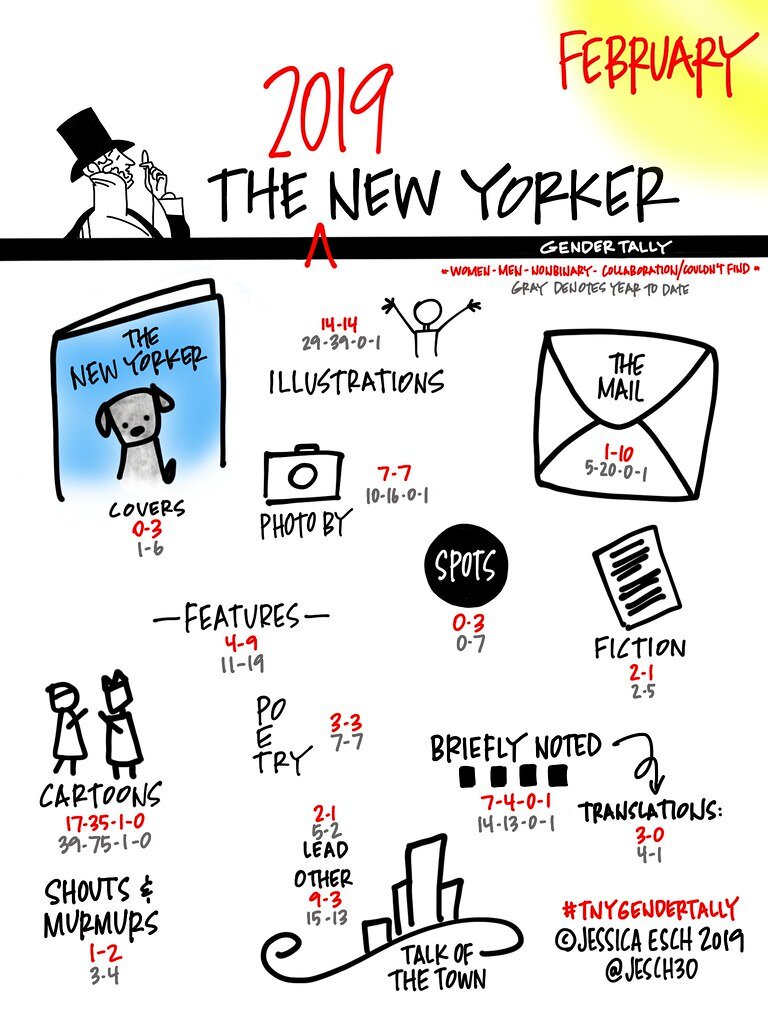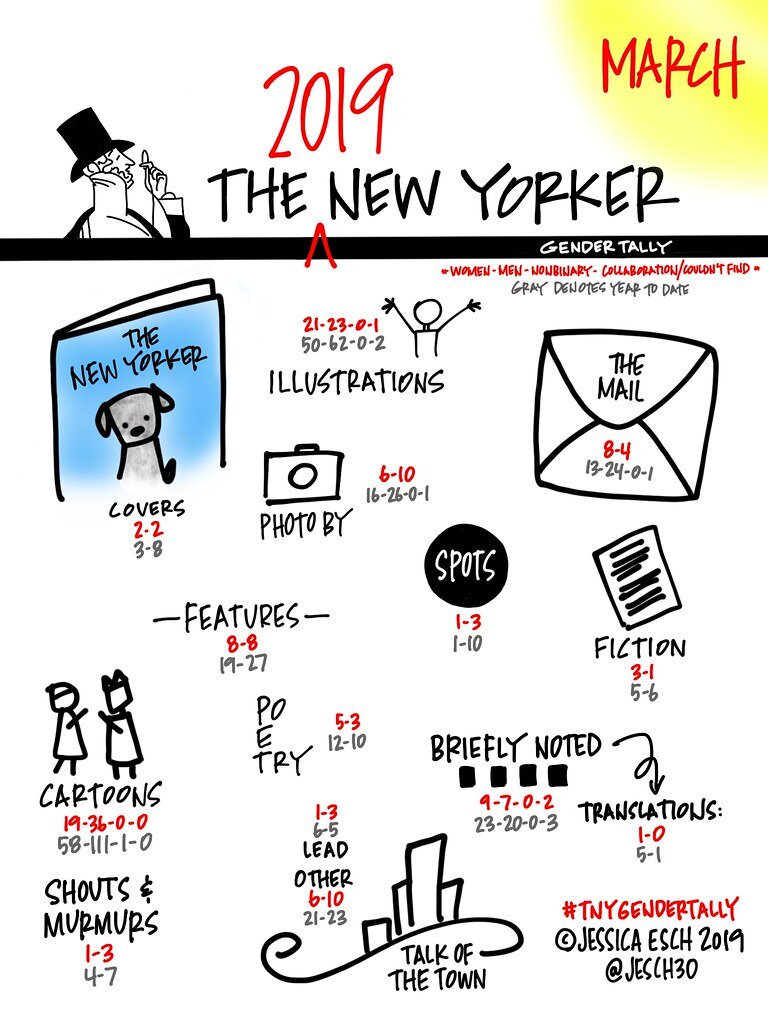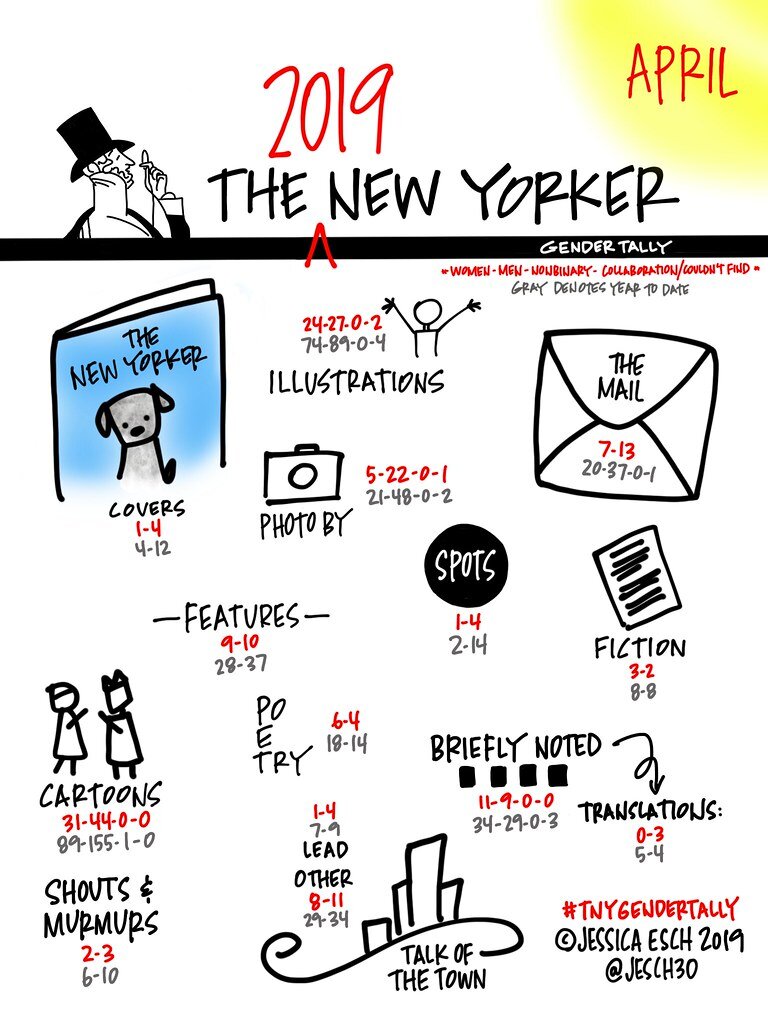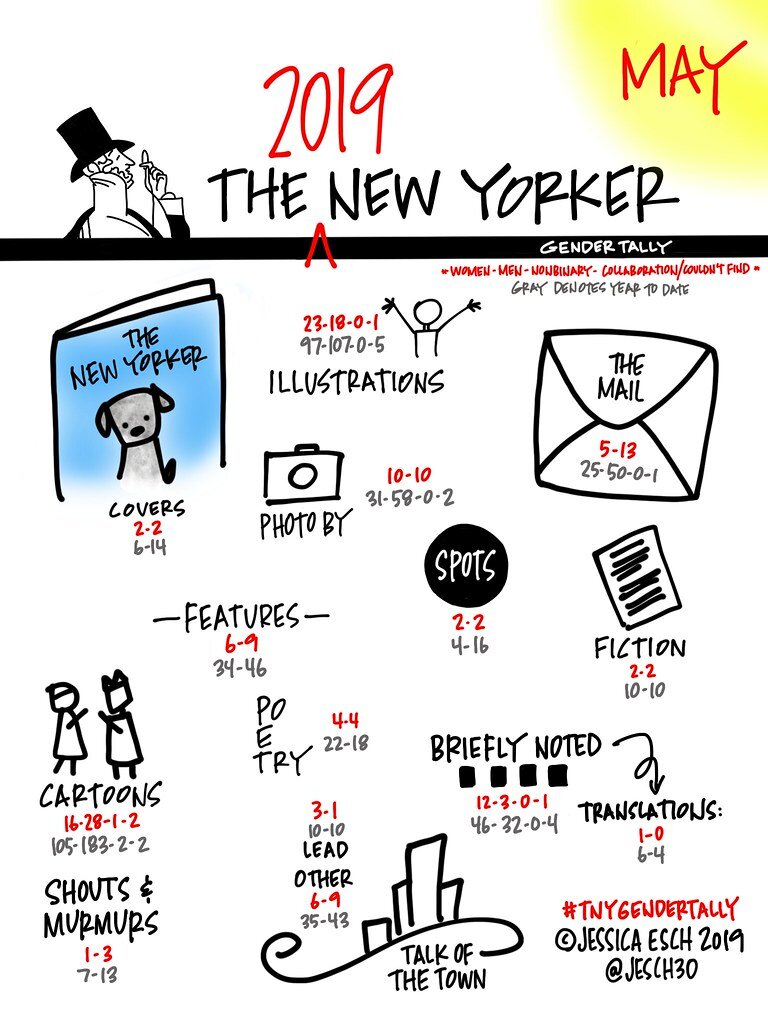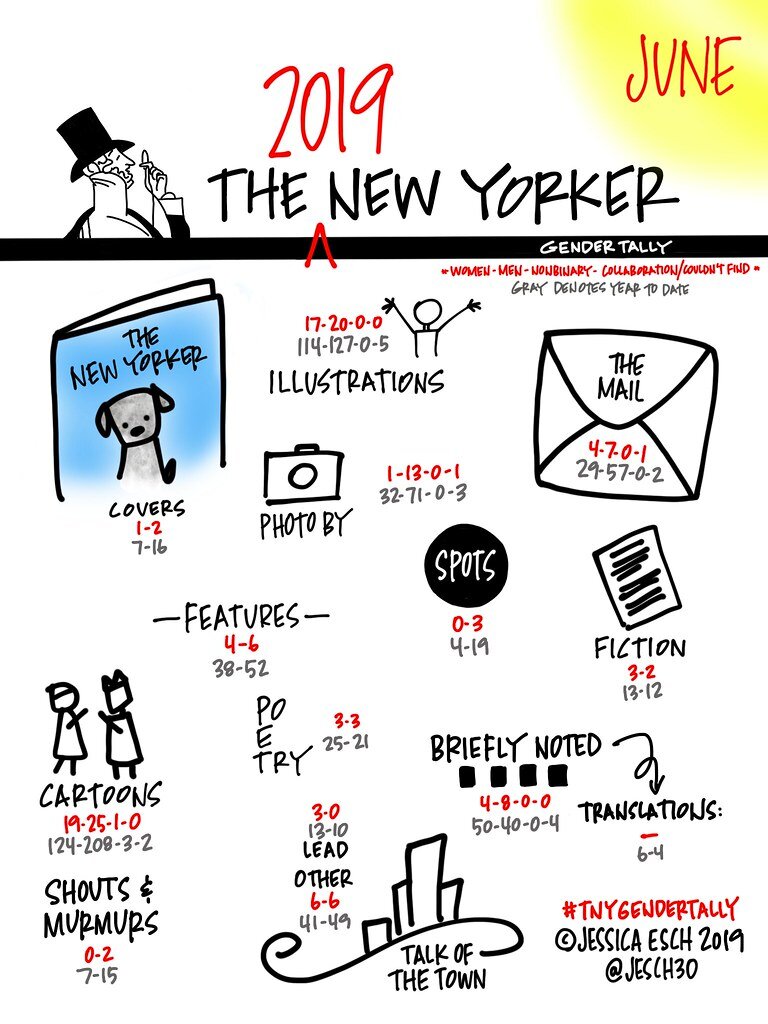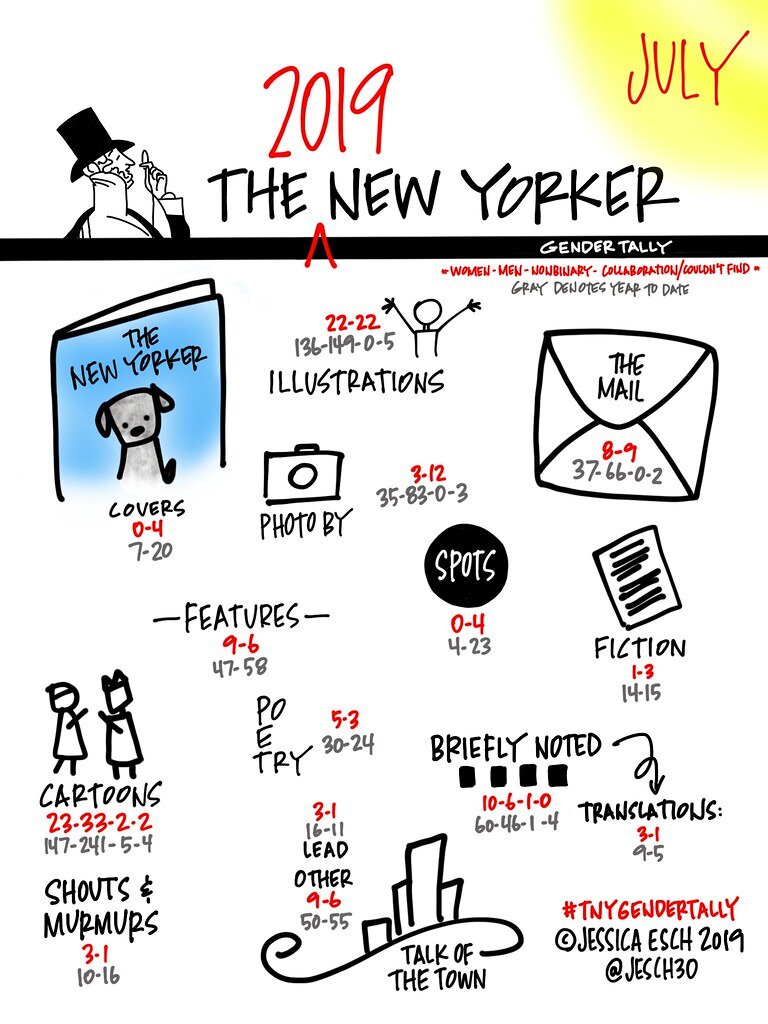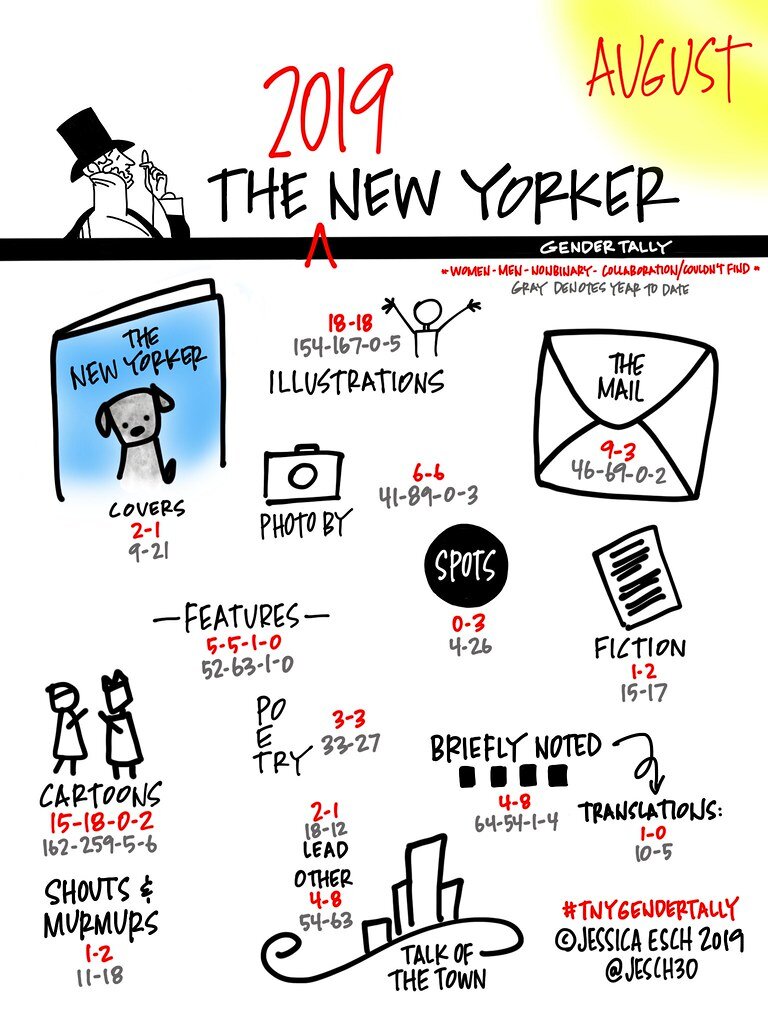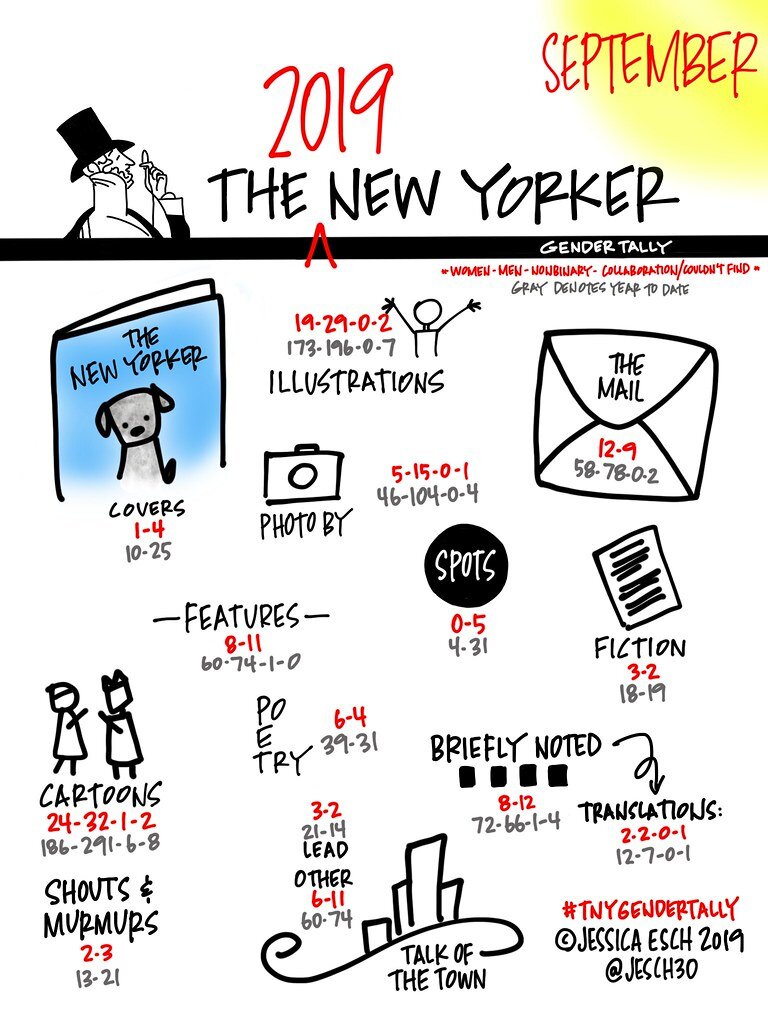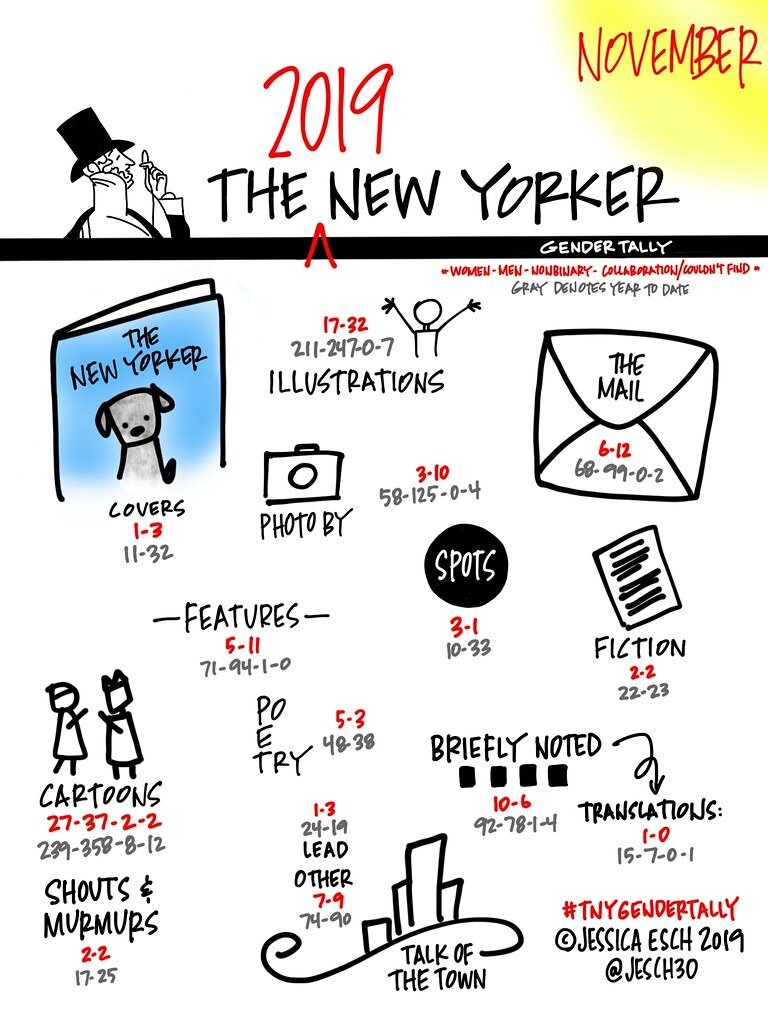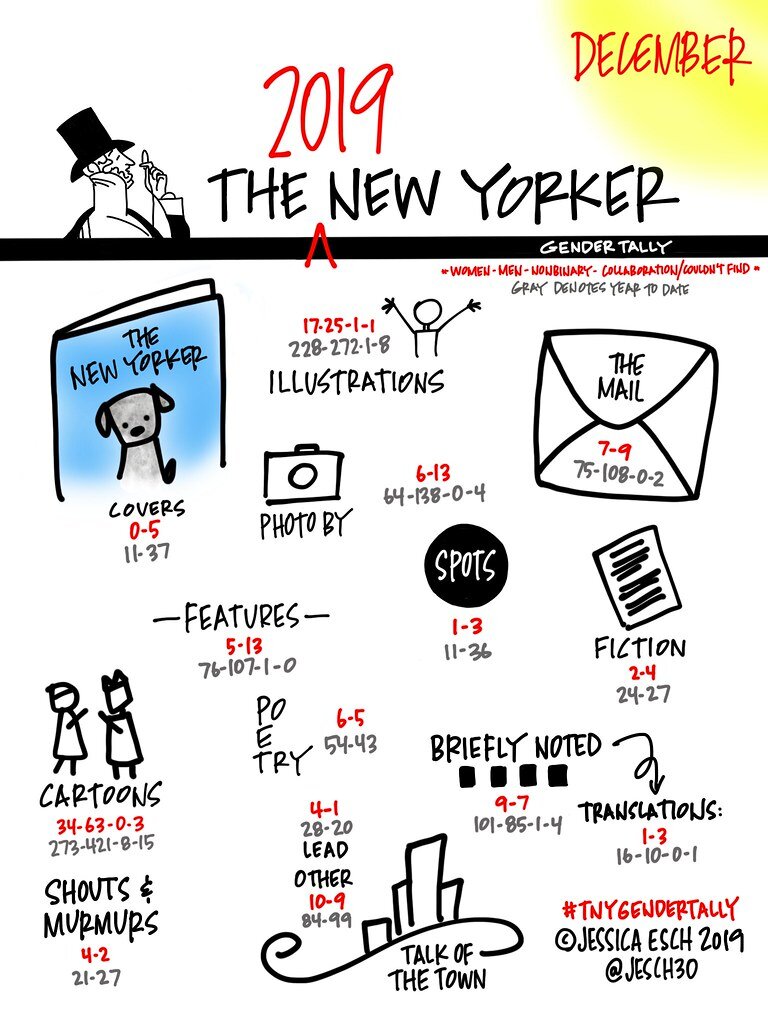The New Yorker Gender Tally: 2019 Year in Review [updated]
The New Yorker Gender Tally looks at The New Yorker magazine contributors by gender. If you’re new to this project, it got fully underway in 2014, and here’s what you need to know:
Women are always listed first, followed by men, and then a catch-all number representing work by studios, collaborations of different genders, or my inability to confirm a person’s gender.
People who are non-binary were added to the Gender Tally in 2019. A count for non-binary is not included if no people who are non-binary are reported. It appears after the count for men.
Gender is determined by name and verifying pronouns.
Previous summaries by year are available at jessicaesch.com.
David Remnick has been editor of The New Yorker since 1998. He said close to 65 percent of the editorial staff is female, and women comprise 60 percent of senior leadership. (Pam McCarthy has been the deputy editor since 1995. Dorothy Wickenden has been the executive editor since 1996.)
Click on the thumbnails below to see each month’s The New Yorker gender tally from 2019:
Takeaways
I have defaced every issue of The New Yorker for six years. I scribble in the margins, calculate totals section by section, and then transfer those numbers to a growing spreadsheet. It’s not always enjoyable, this counting something you love but have no control over.
The results weren’t pretty that first year. Nor the next. Every year, though, showed improvement. Bit by bit. Gender representation in The New Yorker looked much better in 2018 than it did in 2014. Some areas improved steadily over time. Others gained ground and then lost it, only to win more back.
The good news? 2019 was the best yet. Six years of counting are worth it just so I can confidently relay to you that change happens. It probably is not linear, but, in this case, it tacks toward progress.
Read on for my analysis of each section.
Françoise Mouly. Photo credit: Jeffrey Beal [CC BY 3.0], via Wikimedia Commons
Covers
Françoise Mouly has been the covers editor since 1993.
Women logged 11 covers in 2019, two more than 2018 and 2017. There were 48 issues in 2019, and women illustrated 23% of them. For perspective, women had 3 covers in 2014 and 4 in 2015.
Kadir Nelson had the most covers in 2019 (4). Malika Favre had three. The last time a woman had three covers in one year was in 2016. That was Malika Favre too.
(For context, multiple covers per year is not as uncommon for men: Barry Blitt, Tom Gauld, Edward Steed, and Mark Ulriksen also had three covers in 2019. The previous year, though, saw Barry Blitt with six covers and Mark Ulriksen with five. Kadir Nelson had four that year too.)
Illustrations
Christine Curry has been the illustration editor since 1983.
The number of illustrations by women has increased every year since 2014 when 49 were published (14%). In 2019, there were 228 (45%).
My summary for 2018 pointed out that the total number of illustrations spiked in 2016 to 485. I seized the opportunity as a reminder not to read too much into monthly or yearly swings. This year’s numbers prove that true again as 46 more illustrations were published in 2019 than 2018, the highest number since this tally began.
For the second year, I tallied illustrations and photographs in the “Goings On About Town” section separately from those tied to the main articles. My surprise at 2018’s almost perfect gender split (49%) for illustrations became a jawdrop when the final tally showed a 61% split in favor of women. More photographers who are women were published in this section as well (38% up from 25% in 2018). Compare both to the gender breakdown of the illustrations and photographs accompanying main articles in 2019: 28% and 25%, respectively.
Lastly, “Spots” are the series of illustrations spread throughout the magazine that accommodate page layout. They continue to be a male bastion. Eleven of the 47 issues containing Spots illustrations in 2019 were illustrated by women (23%). There remains much room for greater representation here, but this percentage in both 2018 and 2019 is far better than 2014 when women illustrated only three Spots (6%).
Photographs
Joanna Milter has been the photo editor since 2015.
Photographs were tallied for the first time in 2018 thanks to Daniella Zalcman and her Women Photograph project. Of the 206 photographs printed in 2019, 64 were taken by women (31%), and four were collaborations between both men and women. I always find it intriguing when totals do not vary much between years. In 2018, 55 of the 207 photographs were by women (27%). It’s worth noting that 18 of the 72 photos accompanying a feature story were taken by women.
Humor and Cartoons
Emma Allen has been the humor and cartoon editor since May 2017.
While the numbers remain skewed in favor of men, Allen once again delivered more cartoons by women (273 vs 252 in 2018). Allen replaced long-time cartoon editor Bob Mankoff in May 2017. There was surely overlap during the transition, but I do not know how it impacted the cartoons selected. However, the impact of Allen’s involvement stands out in light of the three years of eerie consistency that preceded her (16% in 2016, 15% in 2015 and 2014).
Photo credit: Irving Public Library [CC BY-NC 2.0], via Flickr
Cartoons by Roz Chast appeared in all but two of 2019’s 48 issues. Usually an absence of a Chast cartoon means she’s on the cover or has a full-page illustration elsewhere in the magazine. The September 9 issue was the only one in 2019 that did not include work by Chast. (She had a full-page illustration in the February 18 and 25 double issue. She also had a kick-ass profile by Adam Gopnik in the December 23 issue.
Only two other women published 20 or more cartoons in 2019: Liana Finck (32) and Amy Hwang (21). In 2019, 49 women had cartoons published in The New Yorker. This was 14 more than 2018.
Fun fact: 26% of the cartoons by women since 2014 were by Chast.
Also of note, two cartoonists who are non-binary were published in 2019: Ellie Black had seven and Madeline Claire Horwath added one. There were also 15 cartoons that were collaborations between genders (all female-male).
In 2019 there were 48 installments in the humor section, “Shouts and Murmurs.” Women penned 21 of the 48 (44%), the highest percentage since 2015 (47%).
Talk of the Town
Susan Morrison replaced Lizzie Widdicombe as “Talk of the Town” editor in March 2019.
“Talk of the Town” lead articles are tracked separately. In 2019, 28 of the 48 lead articles were by women (58%). This marked the first time in the span of this tally that women wrote more lead articles than men. (2018 was close: 48%.) While women wrote more non-lead pieces than men for the first time in 2018 (97 of 191), 2019 had them dip a smidge to 46% (84 of 183) and prompted me to consider what success looks like in a tally such as this: gender equality or equity.
Features
Dorothy Wickenden has been the executive editor since 1996.
The gender balance of the features, or the main articles, in 2019 was similar to 2018 (41% vs. 42%). Both welcome increases to the plateau of the preceding three years (37% in 2017 vs 38% in 2016 and 36% in 2015). There were two more feature articles in 2018 than last year and both were written by women.
Fiction
Deborah Treisman has been the fiction editor since 2002.
Of the 51 short stories published in 2019, 24 were by women (47%). Best not to read much into the percentage shifts in this section, since the total numbers written by women are relatively consistent over time. With the exception of 2017, when women wrote 26 of the 49 short stories (53%).
“Briefly Noted” is near the back of each issue and contains four book reviews. For the third year in a row, editors reviewed more books by women than men (101 of 191). 299 of the 567 books reviewed the last three years were written by women (53%).
Translators of books in the “Briefly Noted” section were added to the Gender Tally in 2017. In 2019, 16 of those 27 books were translated by women (59%). This number increased from 12 of 27 translated in 2018 (44%) and 10 of 29 in 2017. (Four additional books in 2017 were joint projects by both women and men. One was included in 2019.) Anyone else find it odd that Briefly Noted included almost the same number of translated books each year?
photo credit: kevinyoungpoetry.com
Poetry
Kevin Young has been the poetry editor since 2017.
Ah, poetry. This section has been a bright spot in the Gender Tally since I added it in 2015. In 2019, it went supernova. Women wrote 54 of the 97 poems published in The New Yorker (56%). And I thought three years of women writing 54% was good.
Jessica Esch is a writer and illustrator who lives in Portland, Maine. Follow her on Twitter at @jesch30.


